The Phototherapy Treatment Market is estimated to be valued at USD 2.2 billion in 2025 and is projected to reach USD 3.6 billion by 2035, registering a compound annual growth rate (CAGR) of 5.2% over the forecast period.
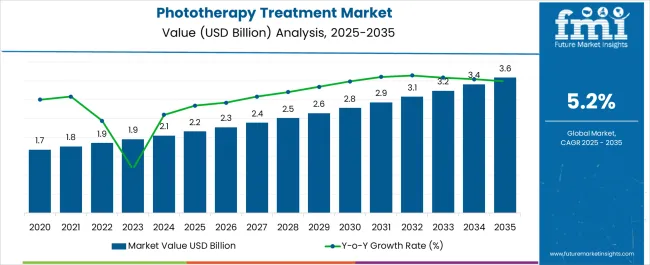
| Metric | Value |
|---|---|
| Phototherapy Treatment Market Estimated Value in (2025 E) | USD 2.2 billion |
| Phototherapy Treatment Market Forecast Value in (2035 F) | USD 3.6 billion |
| Forecast CAGR (2025 to 2035) | 5.2% |
The phototherapy treatment market is experiencing steady growth. Rising prevalence of chronic skin disorders, expanding awareness of non-invasive therapies, and the growing preference for targeted treatment approaches are driving market demand. Current dynamics are shaped by the integration of advanced light-based technologies, regulatory support for safe therapeutic practices, and the growing adoption of phototherapy in both developed and emerging healthcare systems.
Cost-effectiveness compared to long-term pharmacological treatments has further reinforced adoption. The future outlook is defined by increasing clinical research, technological improvements in phototherapy devices, and the expansion of healthcare infrastructure that is facilitating wider patient access.
Growth rationale is anchored in the rising demand for effective and safe alternatives to systemic drugs, the ability of phototherapy to deliver improved patient outcomes in dermatological care, and ongoing strategic investments in equipment innovation and service delivery models These factors are collectively expected to drive sustained expansion of the market over the forecast horizon.

The psoriasis segment, accounting for 42.7% of the disease type category, has been leading due to the high global burden of the condition and the established effectiveness of phototherapy in treatment protocols. Adoption has been reinforced by clinical validation of phototherapy’s ability to manage moderate to severe psoriasis cases. Patient acceptance has been supported by its non-invasive nature and reduced systemic side effects compared to pharmacological alternatives.
Accessibility through specialized dermatology centers and hospitals has contributed to consistent usage rates. Further advancements in treatment delivery systems have improved precision and reduced exposure risks, strengthening physician preference for this modality.
The segment’s growth trajectory is expected to be supported by increasing patient volumes, improved device affordability, and integration into standard care pathways These factors are likely to maintain the psoriasis segment’s strong position in the overall market.
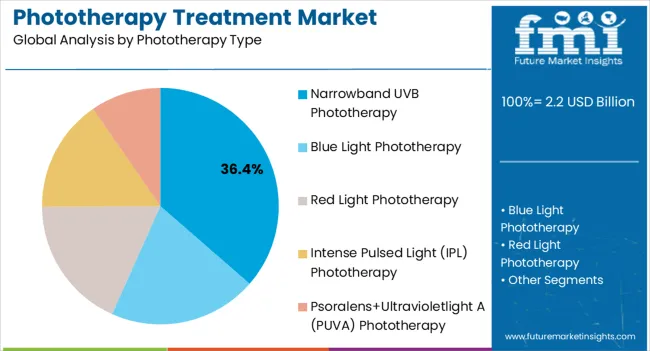
The narrowband UVB phototherapy segment, holding 36.4% of the phototherapy type category, has secured dominance owing to its superior efficacy and safety profile compared to other modalities. Its preference has been reinforced by clinical evidence demonstrating effectiveness in treating a broad range of dermatological conditions while minimizing risks of long-term complications.
Wider availability of UVB equipment and established treatment protocols have facilitated consistent adoption across healthcare facilities. Cost efficiency relative to systemic drugs has supported acceptance among healthcare providers and patients.
Ongoing technological improvements, including enhanced dosimetry and automated treatment scheduling, have further improved treatment accuracy and patient compliance With continued innovation and integration into dermatology practices, the segment is expected to sustain its leadership and expand adoption across diverse geographic markets.
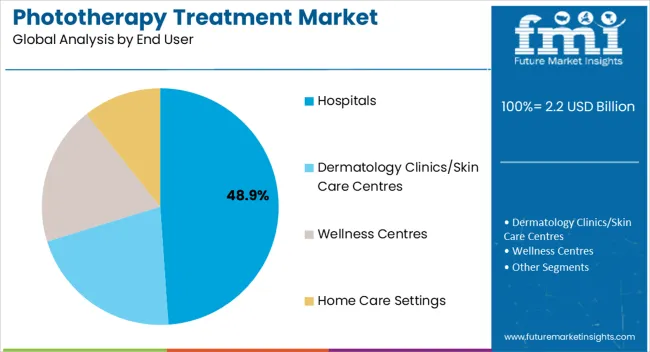
The hospitals segment, representing 48.9% of the end user category, has emerged as the primary channel due to the concentration of specialized dermatology units and access to advanced phototherapy equipment. Adoption has been reinforced by hospitals’ ability to provide comprehensive care, regulatory compliance, and monitoring of patient outcomes.
Centralized treatment delivery within hospitals ensures patient safety and adherence to protocols, making them the preferred setting for phototherapy services. Investment in advanced equipment and staff training has strengthened hospitals’ role in delivering effective phototherapy treatments.
Rising patient inflow, particularly in urban regions, and expanding healthcare infrastructure are supporting further segment growth As hospitals continue to act as hubs for advanced dermatological treatments, their dominance in phototherapy adoption is expected to remain strong throughout the forecast period.
Skin diseases are among the most common of all human health afflictions and affect almost 900 million people in the world at any time. Five common conditions account for over 80% of all skin diseases. These may cause rashes, inflammation, itchiness, or other skin changes. Some skin conditions may be genetic, while lifestyle factors may cause others. Skin disease treatment may include medications, creams, ointments, or lifestyle changes.
Phototherapy has emerged as a highly effective approach to addressing many skin problems in recent years. Phototherapy uses light waves to treat certain skin conditions. The skin is exposed to ultraviolet (UV) light for a set amount of time. Phototherapy uses a man-made source of UV light. UV light also comes from the sun. When combined with a medication called psoralen, the procedure is known as psoralen UVA (PUVA).
UV light shuts down immune system cells in the skin. It can help in skin conditions caused by an immune system overreaction. Some conditions that can be cured using this approach include psoriasis, eczema, mycosis fungoides, and vitiligo, among others. As awareness of phototherapy's benefits in treating acne grows among patients and healthcare providers, more individuals are seeking this form of treatment.
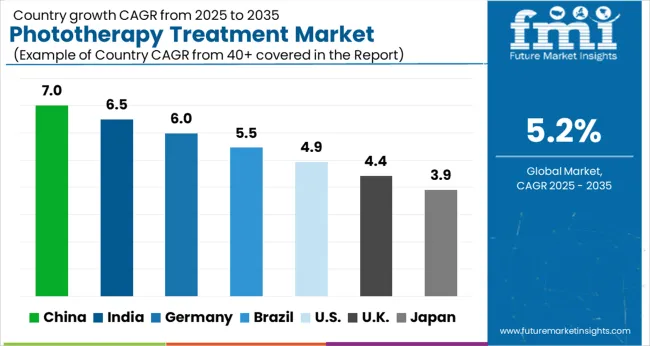
Forecast CAGRs from 2025 to 2035
| The United States | 2.30% |
|---|---|
| Germany | 3.10% |
| India | 7.80% |
| China | 6.70% |
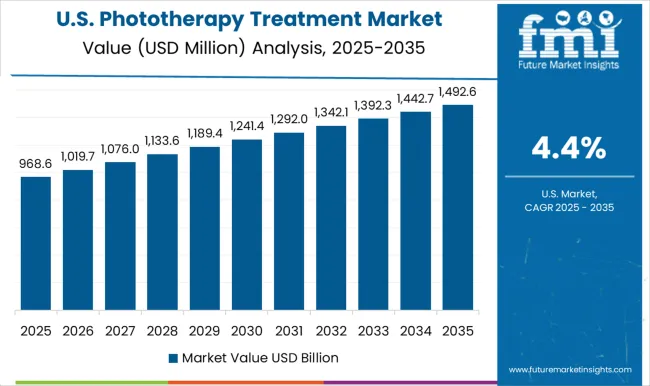
The phototherapy treatment market in the United States has been steadily growing, driven by factors such as the increasing prevalence of skin disorders like psoriasis and eczema. The market has benefited from advancements in technology and a growing acceptance of phototherapy as an effective treatment option
The phototherapy market in the United States is well-developed and advanced, with a high prevalence of skin disorders. Technological advancements and a strong regulatory framework contribute to market growth. Accessibility to phototherapy services is relatively good, particularly in urban areas.
The growing population of adult women suffering from acne and psoriasis is an important factor driving revenue growth of the phototherapy segment. The population of adult women is rising at higher rates in the United States. United States is to account for a CAGR of 2.30% by the end of 2025
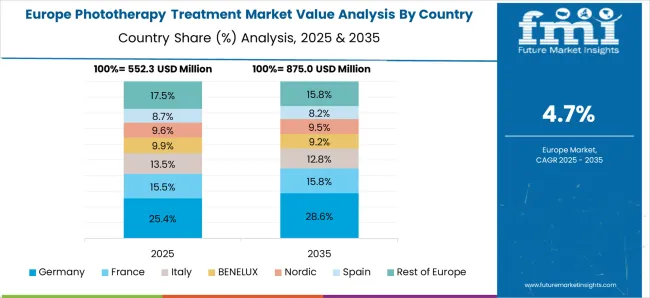
Germany is a major player in the European phototherapy market. The country has a strong focus on healthcare technology and innovation, leading to advancements in phototherapy equipment. High healthcare standards and insurance coverage support the market. Germany is to account for a CAGR of 3.10% by the end of 2025
The market benefits from ongoing research and development in dermatology and a well-regulated healthcare system with access to phototherapy treatments for various skin disorders. The presence of a substantial aging population contributes to the demand for dermatological treatments.
China is to account for a CAGR of 6.70% by the end of 2025. The phototherapy treatment market in China has been growing rapidly alongside the expansion of healthcare infrastructure. A large population and increasing awareness of dermatological treatments drive the market. The country's emerging middle class seeks access to advanced healthcare services. The market benefits from a strong emphasis on cosmetic dermatology and skin conditions.
Rising awareness of modern phototherapy, high per-capita disposable income, and the expansion of healthcare infrastructure is boosting phototherapy treatment in China. Growth in the percentage of newborns in China, an increase in the prevalence of neonatal jaundice, and the necessity for cost-effective treatment are all expected to fuel the market growth in China.
India is likely to closely follow China in the adoption of phototherapy treatment owing to its huge population base in the country. Regulatory reforms, favorable government policies, and improved healthcare infrastructure are expected to influence present and future market trends positively. India is to account for a CAGR of 7.80% by the end of 2025
The phototherapy market in India is growing due to the rising prevalence of skin disorders and increased healthcare spending. Phototherapy is available in major cities and urban centers, and the market is expanding to smaller towns and rural areas.
| Category | Market Share |
|---|---|
| Blue Light Therapy | 42.20% |
| Acne | 60.40% |
By phototherapy type, blue light therapy dominated the phototherapy treatment market for psoriasis and acne and is expected to be the most lucrative segment over the forecast period, with a market share of 42.20%.
Blue light therapy has been found to be effective in treating specific skin conditions, such as acne and actinic keratosis. It's particularly beneficial for those who have not responded well to other treatments. Blue light therapy can reduce the number of acne lesions and improve the appearance of the skin. Blue light therapy is a non-invasive and pain-free treatment.
Patients do not experience discomfort during the procedure, making it more attractive, especially to those who are sensitive to pain or prefer non-surgical options.
Blue light therapy typically has minimal side effects. Patients may experience mild redness or temporary skin dryness, but these side effects are generally well-tolerated and short-lived.
The acne segment is expected to be the largest contributor to the market based on disease type. The acne segment is expected to account for a 60.4% share of the phototherapy treatment market in 2025.
Acne is one of the most common skin conditions globally, affecting a significant portion of the population, particularly adolescents and young adults. This widespread prevalence ensures a continuous demand for effective acne treatments.
Phototherapy, including blue light therapy and red light therapy, has demonstrated its efficacy in treating acne. These treatments can reduce the number of acne lesions, minimize inflammation, and improve the skin's overall appearance.
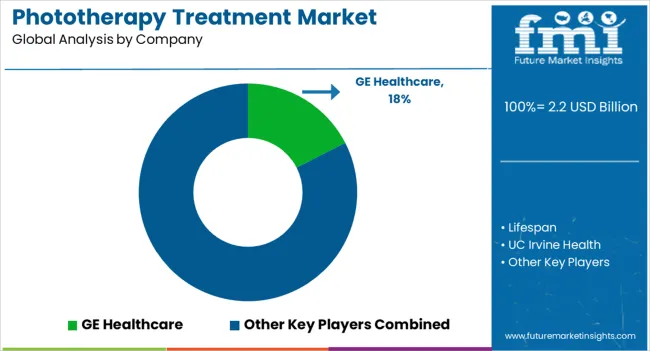
Companies indulged in developing phototherapy treatment therapies are actively seeking to strengthen their position through approval and agreements with established healthcare institutes. Collaborations, mergers & acquisition partnerships with regional players can accelerate their strategy to capture a significant share of the emerging markets.
Some of the developments by players in the phototherapy treatment market are given below-
| Attributes | Details |
|---|---|
| Estimated Market Size in 2025 | USD 1,948.90 million |
| Projected Market Valuation in 2035 | USD 3,230.90 million |
| Value-based CAGR 2025 to 2035 | 5.20% |
| Forecast Period | 2025 to 2035 |
| Historical Data Available for | 2020 to 2025 |
| Market Analysis | Value in USD million |
| Key Regions Covered | North America; Latin America; Western Europe; Eastern Europe; South Asia and Pacific; East Asia; The Middle East and Africa |
| Key Market Segments Covered | Disease type, Phototherapy Type, End-User, Region |
| Key Countries Profiled | The United States, Canada, Brazil, Mexico, Germany, The United Kingdom, France, Spain, Italy, Russia, Poland, Czech Republic, Romania, India, Bangladesh, Australia, New Zealand, China, Japan, South Korea, GCC countries, South Africa, Israel |
| Key Companies Profiled | Lifespan; UC Irvine Health; Buffalo Medical Group; Blackrock Clinic Limited; The Private Phototherapy Clinic Ltd; National Skin Centre Massachusetts General Hospital; Signify Holding; GE Healthcare; Natus Medical Incorporated |
The global phototherapy treatment market is estimated to be valued at USD 2.2 billion in 2025.
The market size for the phototherapy treatment market is projected to reach USD 3.6 billion by 2035.
The phototherapy treatment market is expected to grow at a 5.2% CAGR between 2025 and 2035.
The key product types in phototherapy treatment market are psoriasis, guttate psoriasis, inverse psoriasis, pustular psoriasis, erythrodermic psoriasis, plaque psoriasis, acne, acne vulgaris, acne conglobata, acne fulminans, gram-negative folliculitis, acne rosacea and pyoderma faciale.
In terms of phototherapy type, narrowband uvb phototherapy segment to command 36.4% share in the phototherapy treatment market in 2025.






Full Research Suite comprises of:
Market outlook & trends analysis
Interviews & case studies
Strategic recommendations
Vendor profiles & capabilities analysis
5-year forecasts
8 regions and 60+ country-level data splits
Market segment data splits
12 months of continuous data updates
DELIVERED AS:
PDF EXCEL ONLINE
Phototherapy Lamps And Units For Aesthetic Medicine Market Size and Share Forecast Outlook 2025 to 2035
Phototherapy Equipment Market Size and Share Forecast Outlook 2025 to 2035
Phototherapy Lamps Market Growth - Trends & Forecast 2025 to 2035
Neonatal Phototherapy Devices Market Report – Demand & Forecast 2017-2027
Treatment-Resistant Hypertension Management Market Size and Share Forecast Outlook 2025 to 2035
Treatment-Resistant Depression Treatment Market Size and Share Forecast Outlook 2025 to 2035
Treatment Pumps Market Insights Growth & Demand Forecast 2025 to 2035
Pretreatment Coatings Market Size and Share Forecast Outlook 2025 to 2035
Air Treatment Ozone Generator Market Size and Share Forecast Outlook 2025 to 2035
CNS Treatment and Therapy Market Insights - Trends & Growth Forecast 2025 to 2035
Seed Treatment Materials Market Size and Share Forecast Outlook 2025 to 2035
Acne Treatment Solutions Market Size and Share Forecast Outlook 2025 to 2035
Scar Treatment Market Overview - Growth & Demand Forecast 2025 to 2035
Soil Treatment Chemicals Market
Water Treatment System Market Size and Share Forecast Outlook 2025 to 2035
Water Treatment Chemical Market Size and Share Forecast Outlook 2025 to 2035
Algae Treatment Chemical Market Forecast and Outlook 2025 to 2035
Water Treatment Market Size and Share Forecast Outlook 2025 to 2035
Water Treatment Ozone Generator Market Size and Share Forecast Outlook 2025 to 2035
Water Treatment Equipment Market Size and Share Forecast Outlook 2025 to 2035

Thank you!
You will receive an email from our Business Development Manager. Please be sure to check your SPAM/JUNK folder too.
Chat With
MaRIA